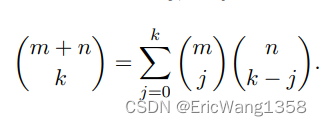[Probability] 1.5 story proof and non-naive def
A story proof is a proof by interpretation.
For counting problems, this often means counting the same thing in two different ways, rather than doing tedious algebra. A story proof often avoids messy calculations and goes further than an algebraic proof toward explaining why the result is true.
The word “story” has several meanings, some more mathematical than others, but a story proof (in the sense in which we’re using the term) is a fully valid mathematical proof. Here are some examples of story proofs, which also serve as further examples of counting.
(Choosing the complement) n choose k = n choose n-k
(The team captain)?
For any positive integers n and k with k ≤ n, n( n-1 choose k-1) = k (n choose k)
This is again easy to check algebraically (using the fact that m! = m(m ? 1)! for any positive integer m), but a story proof is more insightful.
Story proof : Consider a group of n people, from which a team of k will be chosen, one of whom will be the team captain. To specify a possibility, we could first choose the team captain and then choose the remaining k ? 1 team members; this gives the left-hand side. Equivalently, we could first choose the k team members and then choose one of them to be captain; this gives the right-hand side
(Vandermonde’s identity)
A famous relationship between binomial coefficients, called Vandermonde’s identity

Consider a student organization consisting of m juniors and n seniors, from which a committee of size k will be chosen. There are (m+n choose k)?possibilities. If there are j juniors in the committee, then there must be k ? j seniors in the committee. The right-hand side of the identity sums up the cases for j.
(Partnerships).
We can form partnerships by lining up the people in some order and then saying the first two are a pair, the next two are a pair, etc.?
Non-naive definition of probability
Definition 1.6.1 (General definition of probability).
A probability space consists of a sample space S and a probability function P which takes an event A ? S as input and returns P(A), a real number between 0 and 1, as output. The function P must satisfy the following axioms:

Unlike in the naive case, we can now have pebbles of differing masses, and we can also have a countably infinite number of pebbles as long as their total mass is 1.
We can even have uncountable sample spaces, such as having S be an area in the plane. In this case, instead of pebbles, we can visualize mud spread out over a region, where the total mass of the mud is 1.
However, the axioms don’t tell us how probability should be interpreted; different schools of thought exist.
The frequentist view of probability is that it represents a long-run frequency over a large number of repetitions of an experiment.
The Bayesian view of probability is that it represents a degree of belief about the event in question, so we can assign probabilities to hypotheses.
The Bayesian and frequentist perspectives are complementary. Can be used in
(Properties of probability)
(Inclusion-exclusion)
(de Montmort’s matching problem)
本文来自互联网用户投稿,该文观点仅代表作者本人,不代表本站立场。本站仅提供信息存储空间服务,不拥有所有权,不承担相关法律责任。 如若内容造成侵权/违法违规/事实不符,请联系我的编程经验分享网邮箱:chenni525@qq.com进行投诉反馈,一经查实,立即删除!
- Python教程
- 深入理解 MySQL 中的 HAVING 关键字和聚合函数
- Qt之QChar编码(1)
- MyBatis入门基础篇
- 用Python脚本实现FFmpeg批量转换
- CSDN博客重新更新
- React16源码: React中的completeWork对HostText处理含更新的源码实现
- leetcode-路径总和
- 解决Docker添加Docker官方的GPG密钥报错gpg: can‘t open ‘–‘: No such file or directory
- win10电脑提示“KBDSG.DLL文件缺失”,软件游戏无法启动运行,快速修复方法
- Backtrader 文档学习-Cerebro
- 【OSG案例详细分析与讲解】之十二:【时间轴动画】
- 2024年【烟花爆竹生产单位安全生产管理人员】考试及烟花爆竹生产单位安全生产管理人员模拟考试题
- 发布与订阅 geometry_msgs::PoseArray 的消息主题 PoseArrayConstPtr & msg_p 不弹出属性
- 计算机视觉五大技术